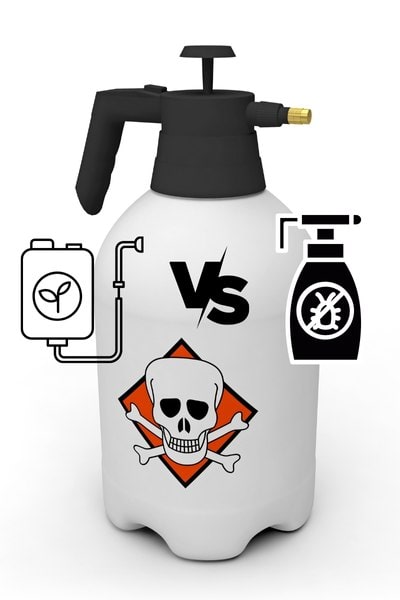Herbicides are chemicals that help control undesirable plants and other vegetation. So, as you can imagine, these substances can be quite strong.
Herbicide spray drift, on the other hand, is the movement of herbicides from the intended area to an unwanted area. In most cases, it’s caused by traveling spray droplets and herbicide vapors.
Many people worry about living next to a farm for this exact reason. But is there really any danger? How far can herbicide spray dirt actually travel?
How Far Can Herbicide Spray Drift Travel?
Herbicide spray particles, particularly the ultrafine ones, can travel in the air, affecting other plants 3.2 kilometers (two miles) away and sometimes even more, depending on the wind conditions. The smaller the particles, the further they can travel.
That’s why it’s important to be aware of herbicide spray drift since it can harm other plants, not just the ones it was directly applied to.
What are the dangers of herbicide spray drift?
Since herbicides are chemicals, they can have an adverse effect on your health, even if you’re exposed to them as a result of herbicide spray drift.
If you’re exposed to herbicides, you may experience irritation of the skin, eyes, face, and throat. The severity of the irritation depends on the type and the concentration of herbicide.
If some herbicide spray gets into your eye, you might get a superficial corneal injury as well.
In addition, swallowing some herbicide spray can lead to throat irritation, increased salivation, and even other problems like nausea, vomiting, and diarrhea.
Since herbicides are used to get rid of undesirable plants, they can kill other plants if it travels further away through the wind.

That’s why it’s recommended to use herbicide spray when there’s no strong wind. That way, you can control which vegetation becomes affected.
In addition, herbicide drift can also negatively impact the environment as a whole by destroying essential plants.
Depending on the type, herbicides can eradicate a lot of plants in a certain area, lowering air quality.
Luckily, in most cases, the dosage of herbicides needed for regular usage isn’t too high.
So, while these chemicals have a negative impact on the environment and our health, they shouldn’t severely affect people who don’t regularly work with them.
Is there a way to prevent herbicide spray drift?

Herbicide spray drift is very difficult to manage. It’s not only affected by the amount of herbicide you use but also by various environmental factors.
If you spray herbicides in an area where there’s a lot of strong wind, they’re more likely to spread far away. But if you use herbicides in an area with little to no wind, there might be minimal herbicide spray drift.
In addition, using an adequate type of herbicide for the area you’re in is also important. Some types of herbicides have small-to-medium particles, which tend to drift long distances since they’re light.
On the other hand, there are some kinds of herbicides that have larger particles. These types of herbicides are better for preventing herbicide spray drift.
They also help protect other surrounding vegetation from being affected by the herbicides.
So, while there’s no foolproof way to prevent herbicide spray drift, there are certain methods you can use to minimize it.
Should you live near herbicide spray drift?

In general, herbicides are used on farms to control and get rid of certain types of plants or vegetation. Because of that, houses and residential areas located close to a farm or agricultural plant are at the highest risk of experiencing herbicide spray drift.
According to research, herbicide spray drift tends to travel as far as about three kilometers away from the place it was used. But this distance might be lower or higher, depending on the wind and type of herbicide used.
As a result, it’s best not to look for houses located within this distance from a farm or agricultural field where herbicides are regularly used.
This is especially the case for people with preexisting conditions, such as dermatological, respiratory, or immunological problems.
That’s because the presence of herbicides in the air can make these issues much worse.
Are herbicides the same as pesticides?

Herbicides and pesticides share many similarities, but they’re not exactly the same.
Typically, herbicides kill or help control certain types of pests, such as weeds. Pesticides, on the other hand, are traditionally used to kill or repel all types of pests, including insects.
Because of that, pesticides tend to be stronger and more toxic than herbicides. Specifically, pesticide drift can harm other animals, such as fish, birds, beneficial insects, and plants that aren’t the target.
Pesticides also have more negative effects on the environment than herbicides. For instance, they can cause loss of livestock and aquatic life, poison the soil, and negatively affect the air quality.
Still, whether you need to use herbicides or pesticides depends on the task you want to be performed. So, it’s not always better to use herbicides.
How long do herbicides stay in the environment?

Herbicides sprayed directly on the desired area can stay there for several months up to three or more years. After that time, they break down into inert compounds in the soil, no longer affecting the area.
With that said, this amount of time depends on the type of herbicide, how much rain the area gets, and how much herbicide was used. So, it can be more or less than that.
Herbicides that have entered the soil as a result of herbicide drift stay in the environment much shorter. That’s because the particles aren’t as concentrated, which allows them to decompose faster.
Conclusion
Herbicide spray drift can travel quite a distance, depending on wind speed and strength, type of herbicide, and other factors. Luckily, herbicides aren’t as harmful to our environment and health as pesticides.
So, as long as you don’t work with herbicides each day, you shouldn’t experience any negative side effects. And if you do, be sure to follow safety guidelines to void serious problems.
Sources: NDSU, Research Gate, MDPI, PMC, and Science Direct

Jack is the owner, chief editor, and senior writer of this website.
Machinery, engines, and farming have always been a passion of his since he was a young boy. Growing up on a small farm in rural America, he learned the value of hard work and dedication from an early age.
After completing his degree in Engineering, he decided to follow his dream and became a farmer in 2009.
Since then, he has gained a wealth of knowledge and experience in the field. He has grown a variety of crops, tended to farm animals, and worked with all sorts of farming machinery. Continue reading…






